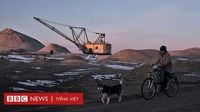On April 30, 2025, the United States and Ukraine signed a significant "economic partnership" agreement, marking a pivotal moment in their relationship amid ongoing conflict with Russia. This agreement allows Washington to access key minerals and natural resources from Ukraine, which has been ravaged by war. The deal was finalized after months of intense negotiations and is expected to facilitate substantial economic recovery for Ukraine while also providing reimbursement for military assistance that the U.S. has extended to Ukraine during the conflict.
The agreement, known as the U.S.-Ukraine Reconstruction Investment Fund, was announced by U.S. Treasury Secretary Scott Bessent, who emphasized that it will enable the U.S. to "invest alongside Ukraine" to unlock the nation’s revenue-generating assets. This partnership aims to accelerate Ukraine’s economic recovery and address the financial support that President Donald Trump has insisted upon for U.S. military aid to the country.
Under the terms of the agreement, both countries will jointly manage and maintain ownership of the investment fund, ensuring that no single party holds overwhelming voting rights. This collaborative approach is intended to foster a sense of equality and mutual benefit between the U.S. and Ukraine.
The fund will be financed through new oil and mineral licenses in Ukraine, with 50% of the total revenue from these licenses directed into the fund. Trump highlighted that this agreement serves as a pathway for the U.S. to recover the approximately $66.5 billion it has provided to Ukraine in military assistance throughout the war.
Following a recent meeting between Trump and Ukrainian President Volodymyr Zelenskyy at the Vatican, Trump expressed optimism that Zelenskyy is eager to reach a deal to end the ongoing conflict. He criticized Russian President Vladimir Putin for continuing large-scale attacks on Kyiv, despite U.S. efforts to broker a ceasefire.
The U.S. Treasury Department described the agreement as a clear signal to Russia, asserting that the Trump administration is committed to a peace process focused on a free, sovereign, and prosperous Ukraine. This sentiment is particularly relevant given the backdrop of heightened tensions and military aggression from Russia.
Ukrainian Minister of Economy Yulia Svyrydenko, who played a crucial role in the negotiations, flew to Washington to finalize the deal after what was described as a breakthrough in discussions with Bessent. Following the signing, Svyrydenko shared the details of the agreement on social media, outlining its scope and implications.
According to Svyrydenko, the agreement establishes a framework for attracting Western investment into Ukraine's mineral, oil, and gas sectors. Importantly, these resources will remain the property of Ukraine, and the country will retain the autonomy to choose the locations for extraction. The cooperation between the U.S. and Ukraine will be structured on a 50/50 basis, with no debt obligations imposed on Ukraine.
As part of the agreement, the U.S. is expected to provide new aid to Kyiv, which may include advanced air defense systems. Svyrydenko noted that income generated from the fund will not be taxed by either nation, further incentivizing investment.
However, the agreement will require approval from Ukrainian lawmakers before it can be fully implemented. Svyrydenko expressed gratitude to all parties involved in facilitating the deal, which acknowledges Ukraine's contributions to global security.
Despite the optimism surrounding the agreement, there are concerns regarding the practicalities of accessing these mineral resources. Ukraine estimates that about 5% of the world's important raw minerals are located within its borders, including approximately 19 million tons of graphite, positioning the country as one of the top five suppliers globally. Additionally, Ukraine boasts significant lithium reserves, which are critical for modern technologies.
Nevertheless, a significant portion of Ukraine's land area—estimated at one-quarter—is contaminated with unexploded ordnance, primarily in the eastern regions that are currently under military conflict. This contamination poses a substantial challenge to any future extraction efforts.
Moreover, Svyrydenko revealed that resources worth an estimated $350 billion remain in territories occupied by Russian forces. The ongoing conflict complicates the situation, as many mineral deposits are located in these areas.
As for Russia's reaction to the agreement, it has yet to issue an official statement. Earlier this year, Putin suggested that Russia was prepared to offer resources to U.S. partners in joint projects, including mining in areas he referred to as "new territories"—a clear reference to regions in eastern Ukraine that have been under Russian control since the full-scale invasion began three years ago.
Putin downplayed the significance of the U.S.-Ukraine mineral agreement, asserting that Russia possesses more abundant mineral resources than Ukraine. He expressed a willingness to engage foreign partners in the development of these resources, further emphasizing the geopolitical stakes involved.
In summary, the U.S.-Ukraine mineral agreement represents a critical step in bolstering Ukraine's economy and securing its sovereignty amid ongoing conflict. As both nations navigate the complexities of this partnership, the potential benefits and challenges will be closely monitored by the international community.




